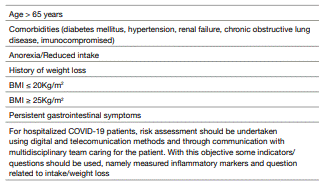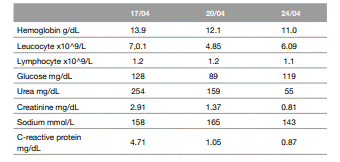INTRODUCTION
There have now been over 211 million confirmed cases of SARS-CoV-2 infection, with close to 4 million deaths worldwide (1).
The risk of severe disease requiring hospitalization and death increases with age, with a case fatality rate of 14.8% in patients over 80 years old compared to 2.3% in the general population (2 - 4). Several reasons might explain this rate disparity. Atypical presentations, thus lacking any specific symptoms of the underlying COVID-19, are frequent in the elderly and may delay the identification and institution of prophylactic measures (3 - 6). There have also been reports describing an increase in viral shedding with age, even more problematic, alongside a recognized increase in difficulty in ensuring social distancing and/or quarantine amongst the elderly (5, 6).
Furthermore, the increase in co-morbidities and a decrease of the physiological reserve in the elderly look likely to contribute further to the risk of complicated and severe infections. The prevalence of various diseases, now known to increase susceptibility to severe COVID-19, also increases with age, e.g., respiratory diseases including chronic obstructive pulmonary disease, diabetes mellitus and cardiovascular disease (CVD) (4 - 6).
In addition, frailty, which can be defined as a geriatric syndrome characterized by an increased vulnerability for developing adverse outcomes, will play a further role, and has, likewise, been associated with worse infectious clinical outcomes, such as, dependency and mortality. Frailty can be caused by and influenced by many factors, such as nutritional status, sarcopenia reduced physical activity, and/ or impaired mental state (5 - 7).
Pandemic mitigation efforts have added several other dimensions that undoubtedly contribute to an increased risk of disease severity associated with worse outcomes in the elderly While in care or hospitalised, these elderly patients are also known to be at risk of malnutrition per se or might have complex needs which will be insidious. Isolation and less frequent bedside care time may also contribute to an overall reduction in the intake of food and fluids. Frequent complications, like the ones highlighted in this report, i.e., altered renal function with hypernatremia or obnubilation/delirium, will place further demand by making treatment needs even more complex. Therefore, undernourished and dehydrated, these dependent patients tend to get sick faster and will get more seriously ill (5 - 8).
CASE DESCRIPTION
We report a case of an 81- year-old man, with a history of prostate cancer surgery. The patient was described as frail by his nursing home carers, and in terms of function, as dependent regarding his daily life activities and by not being able to walk unaided, but otherwise experiencing good health (Clinical Frailty Score CFS (9); of 7). The pre-hospital emergency team was called, by the nursing home staff, because the patient was tachycardic with a pulse of 180 bpm, which was then treated successfully with adenosine.
On arrival at the Emergency Department (ED), the patient had an altered mental state, becoming agitated when care was attempted. Furthermore, he presented with polypnea, and abdominal breathing with intercostal and supraclavicular muscle use, and was also showing signs of dehydration with pale and dry mucosa.
A positive PCR test confirmed a SARS-COV-2 infection and a further chest X-ray showed diffuse infiltrates accordingly. A diagnosis of SARS-CoV2 pneumonia with hypoxemic respiratory failure was made. Laboratory investigations (Table 1), consistent with the severity of the patient condition, indicated acute renal failure and hypovolemic hypernatremia. Very soon after, his state of consciousness degraded and the patient was found to be in a hypovolemic and septic shock. Following a clinical review, which took into account the patient’s frailty, age, pre-hospital emergency event and his unfavourable progression, it was proposed admission to the COVID-19 Internal Medicine ward so that comfort care could be optimised.
There, the patient remained clinically stable despite the severity of his condition. In light of that, rehydration was initiated, but due to safety concerns regarding his altered state of consciousness, a nasogastric tube (NGT) for feeding was put in place. In addition, the patient was considered to be at a high nutritional risk (as defined by the NRS 2002 (10)), which then elicited a nutritional assessment, performed by the multidisciplinary team dedicated nutritionist, following the established COVID-19 assessment protocol - Table 2 (11, 12). This consists of a series of pragmatic adaptations which emphasize multidisciplinary communication between the different settings which share the care for this patient. Due to the bedside access constraints, limited to purely essential clustered care, all required anthropometric insight was achieved remotely, by telephone contact through the nursing home clinical team. Likewise, information about the patient’s dietary habits and preferences, as in a habitual need for soft textured meals, were gathered this way.
This remote, but engaged approach, allowed for a timely implementation of a tailored nutritional care plan adapted to the complex needs identified. Because it was not predictable when the patient would be able to achieve a consistent food intake and having had a nasogastric tube feeding in place, it was proposed that it should be prescribed up to six oral nutrition supplements (ONS) (300 Kcal and 11,8 g of protein for each 200 mL), to be allocated throughout the day and timed to coincide with the routine clustered-care provision. To simplify the procedures these ONS were administered by bolus through the NGT. With these, a total of 1500 Kcal and 59 g protein was achieved.
From that point on, the patient seemed to evolve favourably with reducing oxygen needs, recovering renal function (Table 1) and requiring antipsychotic medication adjustment to his regaining of a more conscious state. Nutritional support was tolerated with intestinal function being restored. On day ten he was clinically discharged, without further requirement for oxygen or nasogastric tube feeding. Due to his social circumstances and COVID-19 mitigation policies, the patient had to be kept admitted until an appropriate discharge for his care home was possible.
Regarding the nutritional intervention presented here, total nutritional requirements were calculated based on the product between a theoretical reference weight (calculated using the arithmetic means of the Butheau and Metropolitan Life Insurance Company formulas) and a deemed suitable activity factor (30). Total requirements were distributed accordingly through macronutrients (1853 Kcal: 92.7 g protein, 61.8 g lipids, 231.6 g carbohydrates). The ONS therapeutic plan was optimized up to six (200 mL) daily intakes so that it would be possible to achieve the nutritional goal of circa 1800 Kcal/daily. Following on from the initial contact with the nursing home staff, it was also noted that the patient ingested soft texture meals and this informed the choice of hospital meals. Nevertheless, and although, after the NGT removal, some progress had been achieved, the soft-texture hospital meals were seldom tolerated. Henceforth, a cream/blended consistency diet was initiated and nutritional support was optimized maintaining ONS at regular intervals, as better tolerated by the patient, so that the bulk of the nutritional needs might be provided. ONS supplements were adjusted until four/day were used, whilst the patient kept an inconsistent meal-time food intake.
At discharge, the continuation of ONS were advised with the nursing
Table 2: COVID-19 ward nutritional screening established protocol - criteria for consideration of nutritional risk

Adapted from PNPAS/DGS and ESPEN
BMI: Body Mass Index
PNPAS/DGS: Programa Nacional de Promoção da Alimentação Saudável/Direção-Geral da Saúde
ESPEN: European Society for Clinical Nutrition and Metabolism
This patient is stable and still resides in the nursing home with his wife. He mantains oral intake and has shown an improvement in mental function, and no worsening of previous dependence state. After one year he remains well.
CRITICAL ANALYSIS
The present case, not being an isolated one, pretends to show the importance of nutritional Care and professionals in their ability to optimize nutritional support on every patient. Nutritional therapy should be integrated at the same level as every other therapy to obtain optimal outcomes, even more in prolonged hospital stays. Older adults seem to benefit even more from this care because access to food and water might be hindered reduced due to complex care needs.
This particular case is relevant because it refers to a dependent patient with low physiological reserve, who was admitted due to SARS-CoV-2 pneumonia septic shock being initially proposed to potential end of life/ comfort care. Notwithstanding , after nasogastric tube placement to achieve optimal hydration and, there was a favourable progress, eliciting a prompt establishment of a individualised nutritional care. To this day, this patient remains well and feeding orally, and although he was already very dependent, no further loss of function was experienced.
In the setting of COVID-19, where the care is clustered and staff safety is a major concern, adequate food intake and optimal nutritional support are harder to achieve. Due to COVID-19 contingency, nutritionists were more remote from the bedside, hence all nutritional assessment information, including anthropometric measures, became a challenge. Which created the need to articulate with relatives or long-term care institutions to obtain some relevant information. Likewise, and at the same time, strategies had to be adopted to mitigate all the in- ward constraints experienced, both by members of the multidisciplinary team and patients, regarding safe and adequate hospital food and hydration provision.
The COPE study which included 772 (49.4%) frail patients with COVID-19 with a median age of 74 years, showed that a higher clinical frailty scale (CFS) was associated with both higher mortality and longer time from hospital admission to discharge compared to patients with low CFS (8). The prevalent pulmonary, cardiac, and/or neurologic co-morbidities mentioned earlier may further contribute to elderly patient frailty. In addition, a correlation was found between frailty status and higher levels of IL-6, CRP and TNF-α. As such, frailty does seem to appear to progress closely with chronic inflammation, which in the elderly might decrease physical reserve and compromise overall health and well-being (8, 13).
Patients at risk for poor outcomes and higher mortality following infection with SARS-COV-2, namely older adults and polymorbid individuals, should be identified regarding their nutritional risk and status through systematic screening and timely assessment. Older adults are also at higher risk due a higher prevalence of comorbidities, body composition changes associated with ageing, which commonly are associated to a gradual loss of skeletal muscle mass and function. Furthermore, additional factors include anorexia, oral and/or chewing problems, psychosocial issues, cognitive impairment and low financial income. In addition, special care most be put to address patients' social status.
An increase in admissions makes it even more important to safely discharge patients as soon as possible. For this reason, social service must also be tightly integrated within the proposed comprehensive multidisciplinary care of COVID-19 elderly patients.
CONCLUSIONS
This is a classic case of the challenges that those that care for elderly, frail patients face, and how exacerbating the circumstances inherent to the pandemic mitigation and the onset of a new complex infectious disease, COVID-19, pose as a test to the ability of dedicated multidisciplinary teams to draw from their best abilities to achieve appropriate case management.
Hospitalized elderly COVID-19 patients will do better, if and when, a full complement of specialist knowledge and expertise is available to direct and provide careful observation and monitoring. Namely, patients at risk for poor outcomes and higher mortality following infection with SARS-COV-2, such as older adults and polymorbid individuals, should be checked for malnutrition through screening and specialized assessment.
Nutritional therapy should be integrated at the same level as every other therapy during COVID-19 clinical management, to obtain optimal outcomes, even more so in prolonged hospital stays. Under current circumstances, older adults may show an increased benefit from these interventions because, and especially if age-related constraints and limitations are present, because even simple access to food and fluids might become easily hindered.
Effective and engaged teamwork will enable appropriate communication between care stakeholders, even during the unprecedented times of pandemic mitigation, and will be essential to achieve safe and timely patient care.















